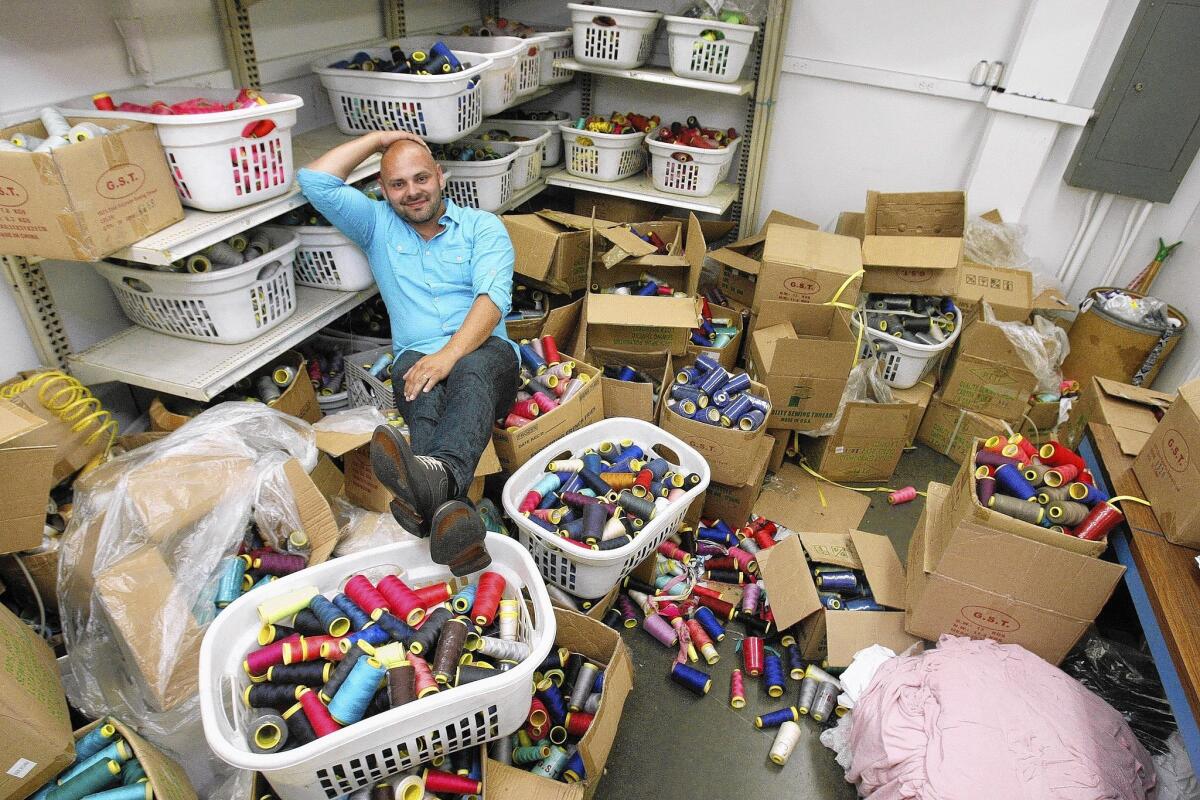Garment broker is seeing rebirth of local apparel factories

Mike Angel Reynoso grew up with the sound of sewing machines.
He played as a boy in his mother’s Lincoln Heights garment factory and helped pack shipments as a teen.
Now 31, he strolls through the Rong Li Fashion factory in Arcadia, where a grinding buzz permeates the concrete floor. Lines of sewers wearing masks and aprons guide dresses under mechanized needles; the strains of Cantonese gossip and Spanish-language radio waft into the pipes and wires overhead.
Reynoso’s life is a one-man chronology of the rare ups and frequent downs of the Los Angeles apparel industry. His childhood reflected the heyday. He came of age during the waves of offshoring and automation that decimated local companies — and his family’s business. Now his career as a garment broker is staked on a shaky rebirth.
Reynoso connects local clothing factories with retailers such as Macy’s and Wet Seal, taking 12% to 15% of the profit per garment. His company, Garment Alliance, contracts with six facilities in Los Angeles and three in Baja California.
That includes Rong Li, which for the first time in decades is making clothes at a cost only slightly higher than Chinese factories’, Reynoso said.
“More factories are opening up now here,” he said, before rushing over to congratulate a foreman on the birth of his first granddaughter. “People are starting to have hope again.”
He hasn’t felt that way in years. U.S. garment manufacturers have been bleeding business to overseas rivals since the 1990s.
In Asia, huge factory complexes, fueled by cheap labor, can handle a garment order from start to finish. Mega-retailers and chains such as Forever 21 and H&M, which sell high volumes of clothing, found the proposition irresistible.
U.S. supply chains, by contrast, include a scattered network of specialist contractors. Factories strain to fill bulk orders and find skilled workers.
A decade ago, nearly 4,000 apparel-making sites operated in Los Angeles County, according to government figures. Fewer than 2,200 remain. Employment has plunged from 90,200 in 1990 to 46,000 last year.
Reynoso attended a clothing and footwear trade show in Las Vegas this year to promote his services. In a cavernous convention hall, 40 American textile and apparel suppliers waited for new clients under a “Made in U.S.A.” banner.
Of the 1,000 companies in attendance, more than 800 were Chinese.
But things were different in Reynoso’s youth. In the 1980s, his mother, Simona Jimenez, bought the Marivere Fashion facility at age 21, four years after immigrating from Guadalajara. The factory cranked out 15,000 garments a week.
Jimenez could earn $1 in profit per garment, a fortune in an industry that now pulls in less than half that. Fat profits fed the mortgages on four other commercial properties. Reynoso attended a private high school and eyed good colleges.
Then foreign competitors, emboldened by rapidly opening borders, began pilfering clients from Marivere and other Southern California garment factories.
The family began letting go of its real estate. Reynoso’s mother was diagnosed with cancer and several stress-induced illnesses.
Reynoso devoted four years to saving Marivere, even working part time at a Starbucks to boost his family’s income. He tried to pick up credits at community colleges but never managed to finish school.
In 2006, the family sold the factory for a fraction of what they had paid for it. The buyer put down a $10,000 deposit but disappeared after stripping the facility of its machinery.
His family filed for bankruptcy several times. His mother took out a loan to try to keep the business running, using the house she had inhabited for 24 years as collateral. During the recession in 2008, the family lost the house, even though Reynoso and his brother refinanced their own homes to try to hold on to the property.
Reynoso found himself without a college degree and few prospects in a dying industry. He bounced from job to job.
There was Fortune Fashions, which ran a screen-printing facility in Vernon that contracted with Wal-Mart, Target and Kohl’s for millions of units a week. Reynoso spent nearly five years with the company, including 21/2 years setting up a sister factory in Mexico.
He was laid off in 2010 when the company was sold. Without his salary of $3,520 a month, Reynoso filed for bankruptcy, listing $22,675 in assets and $25,027 in liabilities. He had just married, becoming a stepfather to his new wife’s young son.
Reynoso tried running his own recording studio and an event-planning business. He served briefly as a distribution manager for a fish company. He was a trims buyer for a small apparel business that filed for bankruptcy within six months of his arrival.
Three years ago, lacking other options and yearning to return to the industry in which he was raised, Reynoso decided to become an independent broker for apparel factories.
Despite his background, he had little idea how to succeed as a broker.
“There’ve been a lot of mistakes made,” Reynoso said, “a lot of money lost.”
He took on more business than he could handle and miscalculated delivery dates. Frustrated customers canceled orders. He tried to learn from another broker, only to have the man steal one of his clients.
Gradually, Reynoso learned the rhythms of his work. He studied the brands and functions of sewing machines so he could understand their capacity. He began partnering with more stable factories. He sought out a respectable mentor.
Last year, Garment Alliance generated $1.5 million in sales and is on track to pull in $2.8 million this year, Reynoso said.
He now works primarily out of Rong Li. The business, operating in a low-lying beige structure on an unexceptional street dotted with other small manufacturers, recently doubled in size to accommodate a surge in demand for U.S.-made products. The factory’s 37 employees make it a giant among Los Angeles garment factories, most of which have 10 to 15 workers.
The plant , owned since 1996 by China native Lilian Li, 58, churns out as many as 100,000 pieces a month for Macy’s.
China, meanwhile, has a glut of factories competing for limited, increasingly pricey labor.
The average Chinese apparel worker is paid $1 to $2 an hour, according to industry consultants — less than the $7.25 hourly minimum wage in the U.S. but much more than workers in smaller countries such as Bangladesh and Vietnam.
And American retailers are becoming wary of ordering clothing from foreign factories, with many raising concerns about low quality and consumer perception.
“It’s been really hard to work in the U.S.,” Li said in Mandarin. “But in just these past two years, there’s been a little bit of a pickup instead of all of our business going to China and Mexico.”
But producing clothing in the U.S. remains difficult.
Intense fluctuations in demand are common. Around Lunar New Year in January or February, factories in China shut down, sending clients streaming into the U.S. looking for stopgap manufacturing. Business at Rong Li often surges from the beginning of the year through March.
This year, however, a brutal winter caused Rong Li’s orders to dive. The factory normally produces 120,000 to 150,000 units a month, but eked out only 80,000 pieces a month through the spring.
Changes in style keep manufacturers guessing. Li was once able to command up to $8 a garment from clients, but because retailers now want simpler basics that are easier to make, she often settles for $3 per piece and takes home a fraction of that as profit.
Still, Li said, “I’ll take any orders they’ll give me, because that way I can at least keep paying my workers.”
The July 1 increase in California’s minimum wage to $9 an hour affected Rong Li’s costs for sewers, office workers, drivers and contract employees.
A lack of available workers is also stressful. Many have aged out of the system, switched to more lucrative industries or found themselves stymied by citizenship requirements. And younger workers have no use for the industry. Most Americans lost interest in garment work after high schools stopped teaching sewing.
“You will see a wave of sewing factories closing in the next two years,” Reynoso said. “Only strong factories that have been to hell and back will survive.”
Yet Reynoso said he’s optimistic. His largest client, a New York firm called Ikeddi Enterprises that sells girls’ brands including Ultra Flirt and Missunderstood, is expanding its Los Angeles contracts to take advantage of the faster turnaround and the U.S. pedigree.
Reynoso expects to expand Rong Li’s capacity 20%, or an additional 20,000 units a month. He has so many orders that he turns down production requests from other companies.
For the first time in a long time, he feels stable.
“Orders and prices have been getting better,” he said. “There’s an awakening — people are buying more ‘made in the U.S.A.’”
Twitter: @tiffhsulatimes







